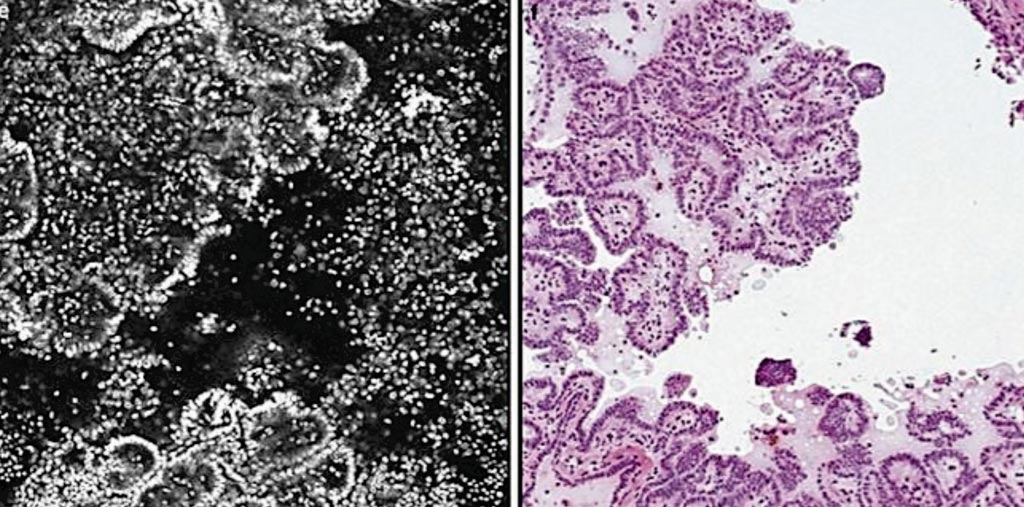Confocal Fluorescence Microscopy Used for Rapid Tissue Evaluation
By LabMedica International staff writers
Posted on 17 Apr 2018
Optical imaging techniques are currently available for imaging tissues without the need for any type of extensive tissue preparation. There are several applications for their potential use in surgical pathology practice.Posted on 17 Apr 2018
Unlike in vivo optical imaging, ex vivo optical imaging is not yet routinely used in clinical practice, although several optical imaging modalities are available for ex vivo tissue examination. These techniques include full-field optical coherence tomography, confocal fluorescence microscopy (CFM), and multiphoton microscopy.

Image: The Vivascope 2500 confocal scanning microscopic view of lymph node metastases from thyroid carcinoma are papillary structures made up of scanty bright spots floating in a dark background (left) (Photo courtesy of IRCSS Santa Maria Nuova Hospital).
Pathology specialists at the University of Texas MD Anderson Cancer Center (Houston, TX, USA) evaluated the feasibility of using a confocal fluorescence microscopy (CFM) platform for ex vivo examination of tissues obtained from surgical resections of breast, lung, kidney, and liver. The team collected fragments of fresh tissue from normal as well as areas of tumor from a total of 55 surgical resections that were performed for malignant tumors of the breast, liver, lung, and kidney soon after completion of immediate intraoperative assessment of the surgical specimen.
The tissue fragments (0.5–1.0 cm) were immersed in 0.6 mM acridine orange for six seconds and imaged using a CFM platform at a 488-nm wavelength. The CFM images of the specimen were obtained using a confocal scanning microscope designed specifically for ex vivo imaging of fresh biologic tissue specimens. The imaged tissues were subsequently fixed in formalin and processed routinely to generate hematoxylin-eosin–stained tissue sections. Mosaics of the grayscale CFM images were studied at different magnifications for recognition of the tissue and were compared with conventional histopathologic examination of hematoxylin-eosin tissue sections.
The scientists imaged 55 tissue fragments obtained from 16 breast (29%), 18 lung (33%), 14 kidney (25%), and seven liver (13%) surgical excision specimens. Acridine orange labeled the nuclei, creating the contrast between nucleus and cytoplasm and thereby recapitulating the tissue architecture. They obtained CFM images of good quality within 5 to 10 minutes that allowed recognition of the cytomorphologic details for categorization of the imaged tissue and were similar to histologic examination of hematoxylin-eosin tissue sections.
The authors concluded that the relative ease and speed of grayscale image acquisition together with the quality of images that were obtained with the CFM platform used in their study suggest that this technique has promise for use in surgical pathology practice. The CFM images are similar to H&E images and the use of this CFM technique for possible applications in surgical pathology, such as rapid evaluation of specimen adequacy of core needle biopsy at the time of procurement, margin evaluation of surgical resection specimens, and quality assurance of the tissues for biobanking, needs serious consideration. The study was published in the March 2018 issue of the journal Archives Of Pathology & Laboratory Medicine.
Related Links:
University of Texas MD Anderson Cancer Center













